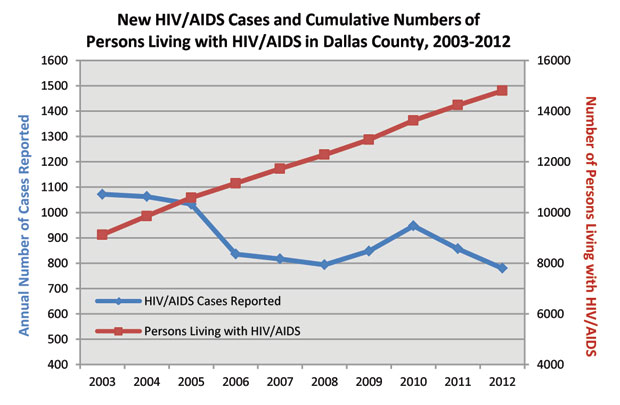Health Director Zach Thompson says county must be vigilant to see a drop in infections among all age groups and categories
The number of new HIV diagnoses in Dallas County decreased in 2012, according to new statistics released by Dallas County Health and Human Services.
While the number of people living with HIV has steadily increased, the number of people diagnosed annually has decreased over the past 10 years. About 15,000 people are living with HIV in Dallas County, a 62 percent increase since 2003. The number of people diagnosed each year has decreased 27 percent over that same period.
AIDS Healthcare Foundation Texas Regional Director Bret Camp sees this as good news.
“Increased testing over the last few years led to more people linked into care that lowers the community viral load,” he said.
The incidence rate among African-Americans and Hispanics decreased from the previous year and over the past 10 years. That is despite a spike in 2010.
Camp said that was when the county became more aggressive in testing and in keeping people in care.
Among whites, the rate has shown a 10-year decrease but is up slightly over the previous year. But the new infection rate among blacks, Hispanics and men who have sex with men remains high.
Of the 780 new cases reported in 2012, 74 percent were among men who have sex with men. Among racial groups, 49 percent of new cases were among African-Americans and 26 percent among Hispanics.
Dallas County Health and Human Services Director Zach Thompson saw the overall decrease in new infections as positive but called the rate among African-Americans and Hispanics disproportionately high.
He said he expects Dallas will continue to have the highest rate of new HIV infections, but Harris County, which includes Houston, will report the highest number of new HIV cases. The rate in 2012 was 31.4 cases per 100,000 people in Dallas County.
Eric Reece, clinical manager at Abounding Prosperity, also noted the disproportionate rate in the black community but noted the number of new infections among African-Americans was also down.
“Targeted testing is working,” he said. “Now we need to look at structural changes to take place.”
He said because 55 percent of new infections were among people ages 13 to 34, that age group isn’t getting the message.
“We shoot ourselves in the foot with abstinence-only education,” Reece said.
He also said availability of condoms is a key to prevention.
Once people test positive, they need to be linked to care, he said. That was one of the reasons Abounding Prosperity was founded and located across the street from AIDS Arms’ Peabody Clinic.
But people who need a place to live are less likely to seek medical treatment or adhere to a drug regimen, so Abounding Prosperity has been working to help clients resolve all of these issues.
From 2008 through 2011, 34 percent of people newly diagnosed with HIV in Dallas County progressed to an AIDS diagnosis within 12 months.
Reece said that was a result of waiting until symptoms began appearing before ever testing.
Camp agreed that frequent testing was important. An early diagnosis and access to medication can prevent damage to the immune system.
“Once you have immune damage, it’s harder to restore,” Camp said.
In 2012, 55 percent of new HIV diagnoses were in people under the age of 35. About 82 percent were among men. The incidence rate decreased in every age group from 2011 and the rate has decreased in all groups except among those aged 13 to 24 over the past 10 years.
“The 13 to 24 rate alarms me,” Camp said. “That’s a generation that doesn’t know the devastation.”
He said it indicated how little schools are doing to teach prevention.
Thompson said that generation didn’t see the devastation of the AIDS crisis.
“They’re coming in at a time when people are living,” he said. “They see people fully functioning.”
Over the coming years, he wants to see a steady drop in the rate of new infections in Dallas County, especially in all of the most affected demographics.
“The only way is through education, reduce the stigma and target the 13 to 35 age group,” Thompson said.
Globally, UNAIDS reported a similar decline in new infections.
In 2012, the agency reported 2.1 million new infections, down from 3.4 million in 2011, a 33 percent reduction in new cases. The UN goal is to halt and reverse the spread of HIV by 2015.
This article appeared in the Dallas Voice print edition October 18, 2013.



